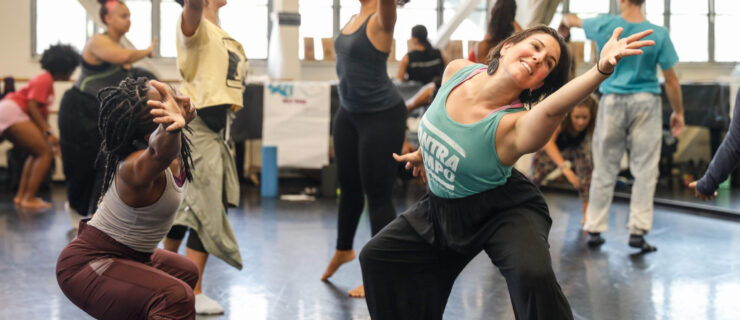Catch Phrase
It’s a wintry afternoon in the second week of rehearsals in a Times Square studio. Square, rumpled FBI agent Carl Hanratty, in the person of Norbert Leo Butz, is leading a group of dancing FBI men and their equally dancing targets under the keen eye of Jerry Mitchell. The choreographer is returning to Broadway after four years of moonlighting—in Las Vegas, London, and television—with Catch Me If You Can.
Moviegoers will remember the Hanratty of Tom Hanks in Steven Spielberg’s fizzy 2002 movie of the same name, which was in turn based on the 1980 memoir by the master con artist and forger Frank Abagnale Jr. (played onscreen by Leonardo DiCaprio). Abagnale, now a security consultant, began his career as a teenage scammer, passing himself off as an airline pilot, a doctor, and other such professionals and living the high life on forged checks and sheer bravado.
Sheer bravado is always a good basis for a Broadway musical, and the number at hand, by Tony winners Marc Shaiman and Scott Wittman, is “Don’t Break the Rules,” in which Hanratty explains his black-and-white view of the world. As the dancers, mostly in black rehearsal clothes and prop fedoras, strut crisply through their steps, the vibe is definitely early ’60s show-dancing, and that’s no accident, Mitchell says. The musical, which opens this month, begins with Abagnale cornered by police. When a shot rings out, he sees his life flashing before him as if it were one of the television spectaculars he watched with his parents as a child.
“It gives license for the characters to sing and dance,” Mitchell says. To get the right flavor, he watched dozens of DVDs of old television variety shows, looking at choreography by the likes of Peter Gennaro and Ron Field.
“I danced for Ron on the Academy Awards,” he says. “I danced with Ron on the television movie Sentimental Journey—I was Cyd Charisse’s partner. I danced on all those Tony Award shows and the old ‘Night of 100 Stars’ specials.” Mitchell’s choreography in “Don’t Break the Rules” marries the stagy architecture of typical TV numbers to a jazz style that will awaken memories for anyone who remembers the Perry Como show. “I’m trying to stick with steps that look like they belong in the ’60s,” Mitchell says, “not steps that belong in 2011. Part of a choreographer’s job is to tell the story in the period in which it’s been written. That’s tough.”
The tough part for the dancers, he says, is replicating the special snap that came through on those TV shows. “The interesting thing about dancing on live television,” he says, “is that your performance energy is at a different level, because you know you’ve got just one shot. So that’s the next step we have to take as a company—how do you push that feeling onto the stage?”
Mitchell provides some answers as he rehearses “Don’t Break the Rules.” There’s a moment when the dancers’ arms fly up, their forefingers stuck out like pistols. First, Mitchell minutely but tellingly adjusts the angle of the upflung arms—“Tight, tight,” he says. Then he turns his attention to those pointed fingers, which aren’t quite pointy enough. “Lemme hear those gunshots,” he tells the dancers.
As he describes what a step should look like (“Drag that toe back”), he’s also telling them what it should feel like (“The pot is starting to boil,” “You’re kicking dirt off that foot”). He demonstrates how a kick sends “a ricochet through my whole body.” He shows them the sharp, clean finish he wants after a jump and then shows them the slumped shoulders and sagging torsos he’s seeing. And when they’re not quite getting to their marks in time for the big finish, he says simply, “To move fast, think small—keep it tight. You’ve got to know where the picture ends.”
While “Don’t Break the Rules” ends with a clear picture—what Broadway types call “a button”—Mitchell says that’s not the case all the way through. As befits a chase story, he notes, “this show never stops moving.” Recalling the last project he worked on with Shaiman, Wittman, and director Jack O’Brien, Mitchell says, “The story in Hairspray was much simpler to tell. The numbers start and they finish. Here, sometimes a number just keeps going into the story, or Hanratty interrupts with new information. They don’t have buttons. Just trusting that has been a real challenge.”
On the plus side, he says, the musical’s television conceit allows him to “do anything.” When Abagnale forges his first check, tap-dancing knives, ink-pots and glue take over the stage. Abagnale’s parents, played by Tom Wopat and Rachel deBenedet, do a routine inspired by the dances Fred Astaire did with Barrie Chase on his television specials. “I’m packing this baby as tight as I can,” Mitchell says with a laugh.
Sylviane Gold writes on theater for
The New York Times.
Mitchell rehearses the ensemble dancers in “Don’t Break the Rules.”




